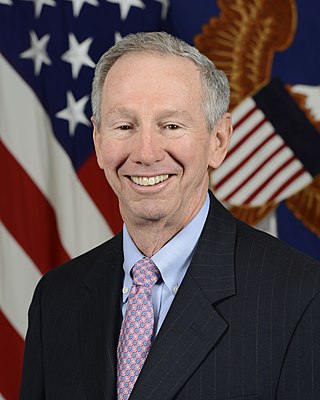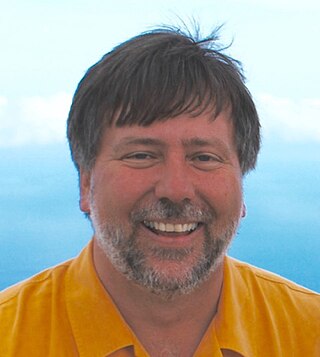
The Jet Propulsion Laboratory (JPL) is a federally funded research and development center (FFRDC) in La Cañada Flintridge, California, Crescenta Valley, United States. Founded in 1936 by Caltech researchers, the laboratory is now owned and sponsored by NASA and administered and managed by the California Institute of Technology.

The ballute is a parachute-like braking device optimized for use at high altitudes and supersonic velocities.

Michael Douglas Griffin is an American physicist and aerospace engineer who served as the Under Secretary of Defense for Research and Engineering from 2018 to 2020. He previously served as deputy of technology for the Strategic Defense Initiative, and as administrator of NASA from April 13, 2005, to January 20, 2009. As NASA administrator, Griffin oversaw such areas as private spaceflight, future human spaceflight to Mars, and the fate of the Hubble telescope.

Dragon is a family of spacecraft developed and produced by American private space transportation company SpaceX.

The idea of sending humans to Mars has been the subject of aerospace engineering and scientific studies since the late 1940s as part of the broader exploration of Mars. Long-term proposals have included sending settlers and terraforming the planet. Currently, only robotic landers and rovers have been on Mars. The farthest humans have been beyond Earth is the Moon, under the U.S. National Aeronautics and Space Administration (NASA) Apollo program which ended in 1972.

William H. Gerstenmaier is an aerospace engineer and policymaker who is the Vice President of Build and Flight Reliability at SpaceX. He previously served as NASA's Associate Administrator for Human Exploration and Operations between 2005 and July 10, 2019. While in that role, he was described as "arguably the most influential person when it comes to US spaceflight." Prior to being Associate Administrator, Gerstenmaier served as the International Space Station Office Program Manager, at Johnson Space Center, a position he began in June 2002. He spent a total of four decades with NASA.

Robert David Braun is an American aerospace engineer and academic. He has served as the dean of the College of Engineering and Applied Science at the University of Colorado Boulder, the David and Andrew Lewis Professor of Space Technology at the Georgia Institute of Technology, and the NASA Chief Technologist. Currently, Dr. Braun is the Space Sector Head at the Johns Hopkins University Applied Physics Laboratory (APL).

Falcon Heavy is a super heavy-lift launch vehicle with partial reusability that can carry cargo into Earth orbit and beyond. It is designed, manufactured and launched by American aerospace company SpaceX.

Mars atmospheric entry is the entry into the atmosphere of Mars. High velocity entry into Martian air creates a CO2-N2 plasma, as opposed to O2-N2 for Earth air. Mars entry is affected by the radiative effects of hot CO2 gas and Martian dust suspended in the air. Flight regimes for entry, descent, and landing systems include aerocapture, hypersonic, supersonic, and subsonic.

SpaceX Mars colonization program is a planned objective of the company SpaceX and particularly of its founder Elon Musk to colonize Mars. The main element of this ambition is the plan to establish a self-sustained large scale settlement and colony on Mars, claiming self-determination under direct democracy. The main motivation behind this is the belief that the colonization of Mars allows humanity to become multiplanetary and therefore secures the long-term survival of the human species in case of Earth being rid of human life.

Susan G. Finley, a native Californian, has been an employee of NASA's Jet Propulsion Laboratory (JPL) since January 1958, making her the longest-serving woman in NASA. Two days before Explorer 1 was launched, Finley began her career with the laboratory as a human computer, calculating rocket launch trajectories by hand. She now serves as a subsystem engineer for NASA's Deep Space Network (DSN). At JPL, she has participated in the exploration of the Moon, the Sun, all the planets, and other bodies in the Solar System.

Jim Cantrell is an American entrepreneur, mechanical engineer and road racer. He is the CEO and co-founder of Phantom Space Corporation, which aims to build space transportation technology. After working at the French Space Agency CNES and the NASA Jet Propulsion Lab, he worked as an independent consultant to aerospace companies for fifteen years and was on the founding teams of SpaceX and Moon Express. Cantrell was a consultant for SpaceX and Elon Musk's industry mentor when SpaceX launched in 2002.
The Mars race, race to Mars or race for Mars is the competitive environment between various national space agencies, "New Space" and aerospace manufacturers involving crewed missions to Mars, land on Mars, or set a crewed base there. Some of these efforts are part of a greater Mars colonization vision, while others are for glory, or scientific endeavours. Some of this competitiveness is part of the New Space race.
The future of space exploration involves both telescopic and physical explorations of space by robotic spacecraft and human spaceflight. Near-term physical exploration missions, focused on obtaining new information about the Solar System, are planned and announced by both national and private organisations.

Sarah Milkovich is lead of Science Operations for the Mars 2020 rover at Jet Propulsion Laboratory. She was investigation scientist for the HiRISE camera on the Mars Reconnaissance Orbiter.

Farah Alibay is a Canadian systems engineer at the NASA Jet Propulsion Laboratory who has worked on the InSight, Mars Cube One, and Mars 2020 missions.

Starship is a two-stage fully reusable super heavy-lift launch vehicle under development by American aerospace company SpaceX. On April 20, 2023, with the first Integrated Flight Test, Starship became the most massive, most powerful, and tallest vehicle ever to fly. SpaceX has developed Starship with the intention of lowering launch costs using economies of scale, aiming to achieve this by reusing both rocket stages by "catching" them with the launch tower's systems, increasing payload mass to orbit, increasing launch frequency, mass-manufacturing the rockets and adapting it to a wide range of space missions. Starship is the latest project in SpaceX's reusable launch system development program and plan to colonize Mars.

The Artemis program is a Moon exploration program led by the United States' National Aeronautics and Space Administration (NASA), formally established in 2017 via Space Policy Directive 1. It is intended to reestablish a human presence on the Moon for the first time since the Apollo 17 mission in 1972. The program's stated long-term goal is to establish a permanent base on the Moon to facilitate human missions to Mars.
Compass, is a collaborative engineering team founded in 2006 in support of the LSAM Design Study at NASA's Glenn Research Center in Cleveland, Ohio. The team primarily performs integrated vehicle systems analyses. The team is a logical extension of Glenn's long history of analysis and design of spacecraft. Compass conducts "studies," in which the team receives a request from a contractor to analyze a space system design. The group reviews the parameters of the design, conducts simulations, details the design, and drafts a final report. Working in real time among engineers and scientists with a wide breath of experience allows designs to come together quite rapidly. Compass designs spacecraft with lofty goals in mind; many of their projects seem like they have come out of a sci-fi film. An example of this is a nuclear-powered robot designed to burrow into Europa. Early success of the team allows it to continue to produce preliminary designs of spacecraft. The name "Compass" was originally based on an acronym that has since been deprecated.

Raptor is a family of rocket engines developed and manufactured by SpaceX. It is the third rocket engine in history designed with a full-flow staged combustion (FFSC) fuel cycle, and the first such engine to power a vehicle in flight. The engine is powered by cryogenic liquid methane and liquid oxygen, a mixture known as methalox.

















